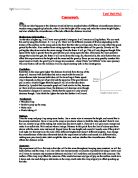To help overcome these systematic errors, we insured that we had the smoothest pulley, and that the surfaces that we used were consistent. In other words, that the table was the same roughness all the way along it, and that the rubber was the same all over.
Manipulating the model
When m2 is released m1 accelerates. These two objects can be looked at separately.
Using .
(1) (2)
(3)
Using (Coulomb’s Law)
(4)
Substituting equation 4 into equation 1
Substituting into equation 3
(5)
Assuming constant acceleration (see note above)
As
Substituting into equation 5
The two variables will be m1 and t. By putting , we can cancel m2 from the equation.
Setting k to be 1022g (this is the lowest weight for which it will still move)
. This is because otherwise m2 hits the floor.
………..1031.8 should be 9.8*1022
This allows us to plot a graph with m1 on the x-axis, and on the y-axis.
Comparing the above equation with shows us that the gradient should be , and the y-intercept should be 0.673. 6.533333333333333333
Conducting the experiment
Again, this diagram shows the layout of the experiment. m2 weighs more than m1.
When m2 is released m1 accelerates. In my model I assumed that this acceleration is constant. However in reality this is not true. As mentioned previously, this will affect my results.
The weight of m1 presses down on the table as the block accelerates. This causes frictional resistance between the block and the bottom of the table. The coefficient of friction between the rubber on the bottom of the block and the table is denoted by μ. By measuring the time taken to move over a specified distance, and by knowing the weight of the two masses it is possible to calculate μ.
Following on from the assumptions above, it is possible to attempt to minimise the effects of these modelling approximations. For instance, if it were possible to ensure constant acceleration then doing this would reduce errors, and make the results more accurate.
- Ensuring that the pulley was as smooth as possible.
- Ensuring that the table was of equal roughness all the way along it.
- Making sure that there is no wind or draughts on the block.
- Making sure that the string is as inextensible as possible.
Variation in experimental results
As in every experiment, there is variation in the results. This is because in, real life, there are more than two variables changing. For example, random draughts, inaccuracy in timing, inaccuracy in measuring distance, inaccurate weights and differences in the table surface.
The error bars on the graph show this error, with the central line showing an average.
Comparison between experimental data and predictions of the model
The predictions of the model give a line of the equation y = -1.37x + 13.8. This gives μ to be 1.14. This is a lot bigger than our original estimate. In addition, 13.8 is approximately twice as big as 6.53. This shows that our experiment does not follow our original model. This is probably due to our assumption that Coulomb’s Law is true. This model will produce a straight line. Our results show a subtle curvature, implying a non-linear relationship between F and μr. Although random variation could have created this curve, it seems that it is due to the inaccurate model of Coulomb’s Law. If the experiment had been based on a non-linear law then a different set of equations would have been derived which would result in a linear function being plotted.
Revision of the process
To improve the experiment, it would be better to use light gates to improve accuracy for timing. On the results that we collected, the higher speeds resulted in wider error bounds and thus less accuracy. This is because it was a lot harder to accurately measure these fast times. Measuring the distances we were moving over more accurately would also increase accuracy, as would more accurate measurement of mass. However, accuracy is not the main issue in this experiment. For this experiment, it seems that our model is incorrect, rather than the results.
To improve this experiment, our assumptions need to be changed. Most assumptions are fine, but the assumption of Coulombs law is very inaccurate. This assumption of a linear relationship forced our results into a curve. To achieve a more meaningful analysis of these results, we need a better model on which to compare them. However, more accurate models for friction are much more complex and far less simple to use.







